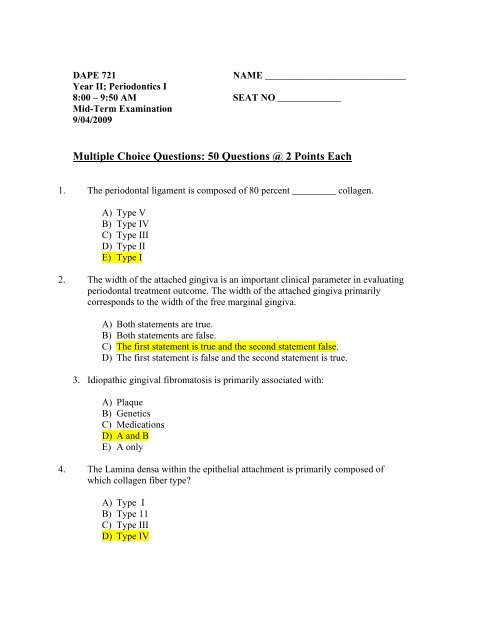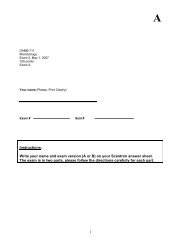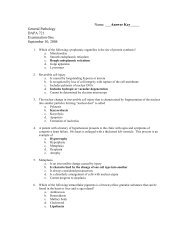Multiple Choice Questions: 50 Questions @ 2 Points Each
Multiple Choice Questions: 50 Questions @ 2 Points Each
Multiple Choice Questions: 50 Questions @ 2 Points Each
Create successful ePaper yourself
Turn your PDF publications into a flip-book with our unique Google optimized e-Paper software.
DAPE 721 NAME _____________________________<br />
Year II; Periodontics I<br />
8:00 – 9:<strong>50</strong> AM SEAT NO _____________<br />
Mid-Term Examination<br />
9/04/2009<br />
<strong>Multiple</strong> <strong>Choice</strong> <strong>Questions</strong>: <strong>50</strong> <strong>Questions</strong> @ 2 <strong>Points</strong> <strong>Each</strong><br />
1. The periodontal ligament is composed of 80 percent _________ collagen.<br />
A) Type V<br />
B) Type IV<br />
C) Type III<br />
D) Type II<br />
E) Type I<br />
2. The width of the attached gingiva is an important clinical parameter in evaluating<br />
periodontal treatment outcome. The width of the attached gingiva primarily<br />
corresponds to the width of the free marginal gingiva.<br />
A) Both statements are true.<br />
B) Both statements are false.<br />
C) The first statement is true and the second statement false.<br />
D) The first statement is false and the second statement is true.<br />
3. Idiopathic gingival fibromatosis is primarily associated with:<br />
A) Plaque<br />
B) Genetics<br />
C) Medications<br />
D) A and B<br />
E) A only<br />
4. The Lamina densa within the epithelial attachment is primarily composed of<br />
which collagen fiber type?<br />
A) Type I<br />
B) Type 11<br />
C) Type III<br />
D) Type IV
5. The epithelial mitotic cell turnover rate is highest within __________.<br />
A) Oral sulcular epithelium<br />
B) Keratinized gingiva<br />
C) Epidermis of skin<br />
D) Junctional epithelium<br />
6. The primary secretion by junction epithelial cells that provides<br />
adherence to the tooth root surface is _____________.<br />
A) Hydroxyglycine<br />
B) Laminin<br />
C) Fibrinogen<br />
D) Glycine<br />
E) None of the above<br />
7. Which of the following statements accurately inter-relates the tooth and<br />
periodontium interface?<br />
A) 1, 2, 3, 4, 5<br />
B) 1, 3, 4<br />
C) 1, 2, 5<br />
D) 2, 3, 5<br />
1. Junctional epithelial cells are oriented parallel to the root surface.<br />
2. Periodontal ligament fibers insert in cementum and bone<br />
biochemically through fibronectin.<br />
3. The junctional epithelial cells are non-secreting cells.<br />
4. The Lamina densa primarily contains hemidesmosomal plaques.<br />
5. Polymorphonuclear leukocytes can pass between junctional<br />
epithelium cells into the gingival sulcus/pocket.<br />
8. In the presence of abundant plaque formation, hyperplastic gingivitis can be<br />
associated with which of the following?<br />
A) 1, 2, 3, 4, 5<br />
B) 2, 3, 4, 5<br />
C) 2, 3,5<br />
D) 2 and 5<br />
E) 4 and 5<br />
1. Mouth breathing<br />
2. Cyclosporine<br />
3. Procardia<br />
4. Pregnancy<br />
5. Phenytoin
9. In periodontal disease, loss of which of the following fiber bundles are primarily<br />
associated in preventing the progressive downward proliferation of the junctional<br />
epithelium into the periodontal ligament and alveolar bone?<br />
A) Transseptal<br />
B) Circular<br />
C) Interradicular<br />
D) Alveolar gingival<br />
10. The “looping” within the vasculature of the free gingival margin is indicative of:<br />
A) Connective tissue pull upon the vasculature<br />
B) Capillary anastomosis within vasculature<br />
C) Leukocyte margination within vasculature<br />
D) Rapid collagen turnover within the connective tissue.<br />
11. Glycosaminoglycans and/or glycoproteins are associated with which of the following<br />
gingival / periodontal histologic structures?<br />
A) Junctional cells<br />
B) Internal basement membrane<br />
C) Collagen fibers<br />
D) External basement membrane<br />
E) All of the above<br />
12. In the (Stage IV) advanced periodontal lesion, collagen fiber lysis is advanced<br />
permitting downward proliferation of the epithelial attachment on the root surface.<br />
The marginal gingival lamina propria is heavily infiltrated by plasma cells.<br />
A) Both statements are true.<br />
B) Both statements are false.<br />
C) The first statement is true and the second statement false.<br />
D) The first statement is false and the second statement is true.<br />
13. Macrophages contained within the periodontium function as which of the following?<br />
A) Phagocytosis<br />
B) Collagen destruction enzymes<br />
C) Initiation of T-Cell production<br />
D) B and C<br />
E) All of the above
14. The alveolar bone proper is also termed as which of the following?<br />
A) 1, 2, 3, 4, 5<br />
B) 1, 3, 4<br />
C) 2, 4, 5<br />
D) 3, and 5<br />
E) 4 only<br />
1. Cribriform plate<br />
2. Sharpey’s plate<br />
3. Lamina dura<br />
4. Bundle bone<br />
5. Trabecular bone<br />
15. Depending upon its local periodontal environment, the fibroblast can function<br />
in which of the following?<br />
A) Synthesis of glycoproteins<br />
B) Phagocytosis of collagen<br />
C) Secretion of trophocollagen<br />
D) Collagenase secretion<br />
E) All of the above<br />
16. The periodontal ligament fiber bundle that least protects the tooth and<br />
alveolar bone during centric axial forces is which of the following?<br />
A) Horizontal<br />
B) Alveolar crestal<br />
C) Obique<br />
D) Apical<br />
17. The predominant immune cell of Initial Lesion, (Stage I), gingivitis, is the:<br />
A) NK lymphocyte<br />
B) Plasma cell<br />
C) Polymorphonuclear leukocyte<br />
D) T-lymphocyte<br />
E) B-Lymphocyte
18. A 27 year-old male presents to your office with the following signs: loss of<br />
interdental and marginal stippling, blue-red tissue color, the junctional epithelium at<br />
the CEJ, and bleeding upon gentle probing. Your diagnosis is __________________.<br />
A) Gingival recession<br />
B) Systemic infection<br />
C) Advanced periodontal disease, (perodontitis)<br />
D) Melanin pigmentation<br />
E) Chronic gingivitis<br />
19. In gingivitis, (Stage II), the predominant cell is the plasma cell. Numerous plasma<br />
cells become phagocytic causing destruction of the horizontal and oblique fibers of<br />
the periodontal ligament.<br />
A) Both answers are true.<br />
B) Both answers are false.<br />
C) The first statement is true and the second is false.<br />
D) The first statement is false and the second is true.<br />
20. Linear-to-curved facial indentations that originate from the apex of the free gingival<br />
margin and extend parallel to the root surface in an apical direction are termed:<br />
A) Free gingival margins<br />
B) Interdental grooves<br />
C) McCall’s festoones<br />
D) Stillman clefts<br />
21. In periodontal health the gingival sulcus primarily contains the following contents<br />
with the exception of:<br />
A) Desquamated epithelial cells<br />
B) PMN’s<br />
C) Transudate<br />
D) RBC’s<br />
22. The oral mucous consists of which of the following?<br />
A. Attached gingival<br />
B. Alveolar mucosa<br />
C. Free gingival margin<br />
D. Mucogingival junction<br />
E. All of the above
23. In health and good tooth alignment, the width of the keratinized gingiva is primarily<br />
narrowest on the facial/ buccal of which of the following teeth?<br />
A) Maxillary lateral incisor<br />
B) Mandibular second molar<br />
C) Mandibular first premolar<br />
D) Maxillary canine<br />
24. The space bounded by the tooth and free gingiva, and having the<br />
Junctional epithelium at its base is termed:<br />
A) Interdental groove<br />
B) Mucogingival junction<br />
C) Free gingival groove<br />
D) Gingival sulcus<br />
E) Interdental papillae<br />
25. The basic function of the gingival fiber groups (apparatus) is to maintain the free<br />
gingiva and junctional epithelium in close approximation to the tooth. The gingival<br />
epithelium lamina propria is similar to other tissues of the body (i.e., consists of<br />
fibroblasts, mesenchymal cells, mast cells, and macrophages).<br />
A) Both answers are true.<br />
B) Both answers are false.<br />
C) The first statement is true and the second is false.<br />
D) The first statement is false and the second is true.<br />
26. Which of the following parameters are indicative of gingival health?<br />
A) Bleeding upon probing<br />
B) Gingival enlargement<br />
C) Inverted interdental gingival contours<br />
D) Firm consistency of gingival margin<br />
27. A stippled appearance is normal to the attached gingiva. This stippling is caused by<br />
projections of elastic fiber bundles into the papillary layer of the lamina propria,<br />
which elevate the epithelium into rounded prominences that alternate with<br />
indentations of the epithelium.<br />
A) Both answers are true.<br />
B) Both answers are false.<br />
C) The first statement is true and the second is false.<br />
D) The first statement is false and the second is true.
28. In the adult periodontium, the junctional epithelium:<br />
A) have fewer hemidesmosomes<br />
B) coronally the junctional cells are 1-2 cell thick<br />
C) does not secrete glycoprpteins or glycoaminoglycans<br />
D) during all stages of eruption, the junctional cell adhesion is limited to the<br />
CEJ.<br />
29. Recession of junctional cells apical from the CEJ, is related to which of the<br />
ollowing?<br />
A) Position of the tooth in the arch<br />
B) Infection associated with plaque<br />
C) Calculus formation<br />
D) Toothbrush trauma<br />
E) All of the above<br />
30. The blood vessels within the connective tissue adjacent the junctional epithelium are<br />
named:<br />
A) Endosteal arterioles and capillaries<br />
B) Periosteal arterioles and capillaries<br />
C) Interdental artery<br />
D) Crevicular plexus<br />
31. The periodontal ligament is capable of transmitting tactile pressure and pain<br />
sensations by the trigeminal nerve pathways. The sense of localization during closure<br />
is imparted through the high elastic fiber content of the periodontal ligament.<br />
A) Both answers are true.<br />
B) Both answers are false.<br />
C) The first statement is true and the second is false.<br />
D) The first statement is false and the second is true.<br />
32. Bundle bone is named because of which of the following reasons?<br />
A) The formation of multiple lacunae within alveolar cortical bone.<br />
B) The site of embedded Sharpey’s fibers.<br />
C) The incorporation of intrinsic fibers within the alveolar bone proper.<br />
D) Collagen arrangement within trabecular spaces.<br />
E) Remnents of cementum deposition in the alveolar bone proper.
33. Generally, acellular cementum is not:<br />
A) Is not replaced when root planed to dentin<br />
B) Is associated with supragingival calculus<br />
C) Primarily involved in root ankylosis<br />
D) Is laid down in appositional layers<br />
E) Is formed before the tooth erupts into the oral cavity<br />
34. The dento-gingival unit is a “dynamic structure”. This refers to which of the<br />
following?<br />
A) Remodels bone and cementum<br />
B) Adapts to compensatory eruption<br />
C) Permits mesial drift of the tooth<br />
D) Performs a formative function<br />
E) All of the above<br />
35. Gingival recession may be associated with which of the following?<br />
A) Advancing periodontal disease<br />
B) Position of the tooth in the arch<br />
C) Mucogingival involvement caused by frenum pull<br />
D) Occlusal traumatism<br />
E) All of the above<br />
36. Tooth # 24 has 3mm. of exposed lingual root as measured by a probe from the CEJ to<br />
the free gingival margin. Your periodontal diagnosis is:<br />
A) Gingivitis<br />
B) Fenestration<br />
C) Gingival enlargement<br />
D) Gingival abscess<br />
E) Recession<br />
37. With recession, which of the following best describes ACTUAL POSITION?<br />
A) The level of the crest of the gingival margin on the tooth.<br />
B) The level of the epithelial attachment on the tooth.<br />
C) The depth of the gingival sulcus or periodontal pocket.<br />
D) Measured by use of the periodontal probe<br />
E) B and D
38. Generalized diffuse gingivitis includes the following periodontal tissue:<br />
A) Attached gingiva<br />
B) Interdental gingiva<br />
C) Marginal gingiva<br />
D) Alveolar mucosa<br />
E) All of the above<br />
39. During an acute gingival inflammatory response, which of the following cell types<br />
can destroy virulent bacteria by phagocytosis and T-cell mediation?<br />
A) Plasma cell<br />
B) Mast cell<br />
C) B-Lymphocyte<br />
D) Macrophage<br />
E) Polymorphonuclear leukocyte<br />
40. In health, mesial drift results in changes within periodontal alveolar bone; these<br />
changes are best described as:<br />
1. osteoclastic activity and loss of collagen on the pressure side.<br />
2. necrosis and osteoclastic activity on the tension side.<br />
3. Osteoblastic activity and collagen formation/mineralization on the<br />
tension side.<br />
4. cementoblastic and collagen mineralization on the pressure side.<br />
5. apical osteoblastic ankylosis.<br />
A) 1, 2, 5<br />
B) 1 and 2<br />
C) 1 and 3<br />
D) 3 and 4<br />
E) 3, 4, 5<br />
41. In health, the color of the attached gingiva is blue-red in color. This color of the<br />
healthy attached gingiva is produced by the vascular supply, thickness of the<br />
keratinized epithelium, and/or the presence of pigmentation.<br />
A) Both answers are true.<br />
B) Both answers are false.<br />
C) The first statement is true and the second is false.<br />
D) The first statement is false and the second is true.
42. A fenestration primarily occurs:<br />
A) 1, 2, 3, 4<br />
B) 1 and 3<br />
C) 2 and 3<br />
D) 3 and 4<br />
E) 1 only<br />
1. In lingual bone rather than facial bone.<br />
2. Where facial buttressing bone is heavy apically.<br />
3. Where a root is facially prominent in the arch.<br />
4. Where the denuded root area is located apical to the marginal<br />
bone.<br />
43. Clinical research reports that ____________of erupted teeth have a partial absence of<br />
cervical cementum forming a space of exposed dentin. This exposed dentin space<br />
may be associated with an increased incidence of caries and root sensitivity.<br />
A) 5-10 %<br />
B) 30-<strong>50</strong> %<br />
C) 60-65 %<br />
D) over 65 %<br />
44. Enamel projections can extend varying distances from the dentoenamel junction to<br />
the mid-facial furcation areas. An epithelial attachment associated with these enamel<br />
pearls is potentially weaker than a comparable epithelial attachment on cementum.<br />
A) Both answers are true.<br />
B) Both answers are false.<br />
C) The first statement is true and the second is false.<br />
D) The first statement is false and the second is true.<br />
45. Gingival bleeding with gentle probing may be associated with which of the<br />
following?<br />
A) Chronic gingivitis<br />
B) Overzealous tooth brushing<br />
C) Leukemias<br />
D) Violation of the biologic width<br />
E) All of the above
46. In periodontal health, the distance between the epithelial attachment to the crest of the<br />
alveolar bone remains relatively constant at 2.04 mm. As the epithelial attachment<br />
moves apically in periodontal disease, the crest of the alveolar bone is resorbed in<br />
attempt to re-establish this 2.04 mm distance.<br />
A) Both answers are true.<br />
B) Both answers are false.<br />
C) The first statement is true and the second is false.<br />
D) The first statement is false and the second is true.<br />
47. Which of the following histologic structures are generally absent within the<br />
periodontal ligament?<br />
A) angioblasts and undifferentiated cells<br />
B) mylenated nerve fibers<br />
C) interstitial spaces<br />
D) fibronectin<br />
E) mature elastic fibers<br />
48. Remodeling of the periodontal ligament and bone by fibroblasts, cemenoblasts,<br />
osteoblasts, and osteoclasts is an example of ______________ cellular function?<br />
A) Physical<br />
B) Formative<br />
C) Sensory<br />
D) Anatomical<br />
E) None of the above<br />
49. Tooth number 25 has a nonkeratinized gingival margin and probes 5 mm loss of<br />
attachment from the CEJ. There is facial alveolar mucosal elastic pull associated the<br />
pull of the mandibular labial frenum. These presented diagnostic findings are<br />
consistent with a diagnosis of:<br />
A) Hyperplatic gingivitis<br />
B) Gingival recession<br />
C) Mucogingival defect<br />
D) None of the above
<strong>50</strong>. Tooth number 14 has been without an antagonist for 18 months. You place a<br />
mandibular bridge from teeth numbers 18 – 20, restoring occlusal function to<br />
number 14. Histologic changes within the periodontium of tooth number 14 now<br />
include:<br />
A) 1, 2, 3, 4, 5<br />
B) 1, 3, 4<br />
C) 2, 3, 4, 5<br />
D) 2 and 3<br />
E) 1 only<br />
1. A functional periodontal ligament space.<br />
2. Decreased density within supporting bone.<br />
3. Increased density of the alveolar bone proper.<br />
4. Reorganization, formation, and orientation of periodontal<br />
fiber groups.<br />
5. Deposition of acellular cementum.

















